#samurai eboshi
Explore tagged Tumblr posts
Text
Formal outfits for upper ranks samurai & Most formal for lesser ranks samurai - Hitatare, Daimon and Suô court dress,
(as worn by samurai of the Edo period - great charts by Nadeshico Rin). You can find more about samurai ranks and their regulated attires under the tag "samurai kimono".
The Hitatare
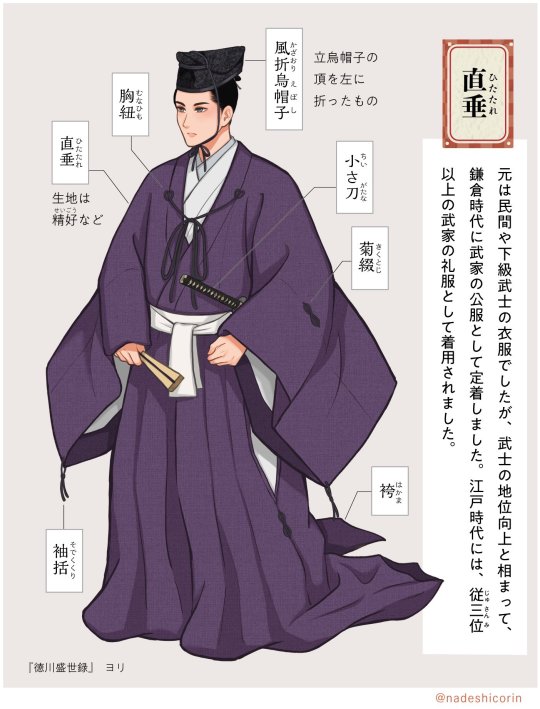
直垂 Hitatare first appeared as an attire worn by lower class warriors. As buke (warrior class) rose into status, it was slowy established as a formal garb for samurai during Kamakura period.
In Edo period, hitatare was the most formal attire worn by samurai of the 3rd rank and above. Fabrics used were luxurious, such as 精好織 seigo-ori (a type of textured silk, also used for Shinto priest clothing nowadays).
風折烏帽子 Kazaori-eboshi - black-lacquered hat made of silk, cloth or paper, originally worn by Heian nobility. Many eboshi shapes exist, this one is a upright style (tate-eboshi 立烏帽子) with top folded to the left.
袴 Hakama - formal pants, more exactly 長袴 nagabakama trailing pants
小さ刀 Chîsagatana - a small decorative katana
胸紐 Munahimo - chest ties, first appeared on Heian nobility clothes
菊綴 Kikutoji - decorative tassel-like knots, first appeared on Heian nobility clothes
袖括 Sodekukuri - decorative sleeve ties. Originally appeared on Heian clothings (like kariginu, nôshi, etc) where they were used to tighten sleeve cuffs. Later types like the tiny ones above are purely decorative.
The Daimon
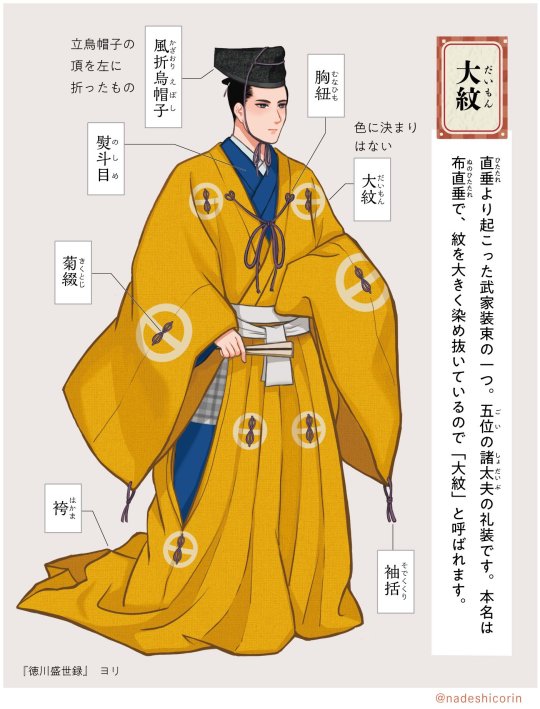
The 大紋 daimon is a specific hitatare set patterned with large 紋 mon (clan/family crests). It was worn by fifth court rank samurai (rank of the daimyô lords for example).
It was put over a 熨斗目 noshime, a type of kosode (=ancestor of the kimono) worn by samurai, with stripes or lattice pattern around waist area.
The Suô
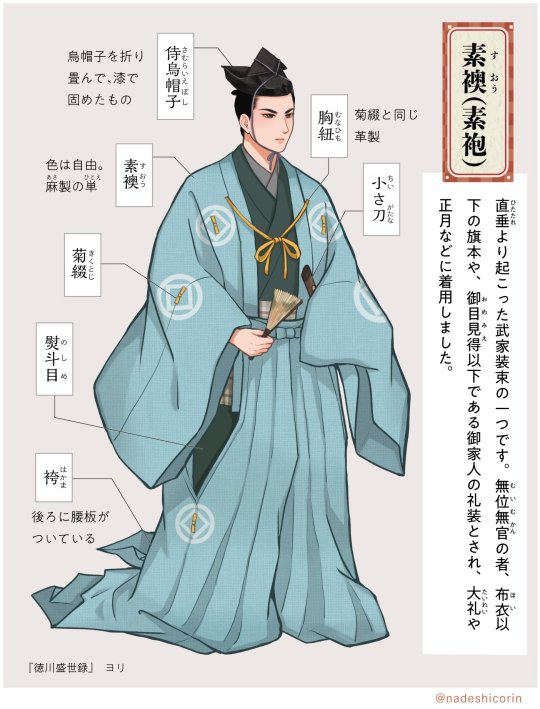
The 素襖 Suô, also a variation of the hitatare, was the ceremonial dress of the lower-ranked samurai. Via explicit permission of the shogunate, some samurai could be granted the right to wear 布衣 hoi (a type of kariginu).
It looked very similar to daimon set, but showed fewer crests of much smaller size. The hat was also different as they wore one called a 侍烏帽子 samurai eboshi.
#japan#fashion#fashion history#samurai kimono#samurai#nadeshico rin#edo era#edo period#buke#warrior class#men kimono#Hitatare#Daimon#Suou#Suo#着物#reference#ressources#Kazaori-eboshi#Hakama#Chîsagatana#Munahimo#Kikutoji#Sodekukuri#noshime#samurai eboshi
296 notes
·
View notes
Text
Understanding Princess Mononoke

People on twitter have asked me to write this up, after speaking just a bit about it on the bird plattform.
So, recently I rewatched Princess Mononoke and talked about it with a friend, who is Japanese with a degree in Japanese history. And I think some of it was rather interesting.
Some of you might already know this. But others might not. So just endulge me for a moment.
Let me start with Ashitaka. The movie does mention that he is Emishi - but many people are not aware, what this means.
See, Japan had quite a lot of indigenous cultures (I will talk more about those tomorrow). Most might know the Ainu, as they are still around today. Fewer might know about the Ryukyuan people of Okinawa, who are also still around. But there are several indigenous people, who have once lived in Japan, but whose culture hence had become instinct. The Emishi are one of them. They lived in Northern Honshu and their culture disappeared around the 10th century.
The movie, of course, takes place in the late 14th century, which is why the monk notes, that he knows what Ashitaka is, but will keep it secret. The idea is that Ashtakas little village had stayed secret to avoid being destroyed. As such Ashitaka has a different relation to the nature and the nature spirits than the other characters of the movie, who are to engrossed in the mainly Buddhist culture.
Another thing that has to be addressed is Iron Town and Lady Eboshi's people. According to the official Japanese material to the movie, Lady Eboshi once was a prostitute herself, who happened to get power by getting taken to China. Which is why she is in possession of the Chinese gun technology. She then decided to use that to allow herself power - but not entirely out of selfish reasons. Because she, of course, takes in untouchables. Japan, to this day, has an untouchable caste. Which are people who work certain "dirty" jobs or sicknesses. Most of the women in Iron Town are prostitutes who Eboshi had bought free from their brothels. And she wants to have a town where those people can live good lives.
Because of this she has to hope for the support of the Emperor, as the Samurai lords in the surrounding areas do not want her there.
Which brings me to the finale and killing the god. Here is a thing that you have to understand of Japanese history. The original indigenous people of Japan believed in nature spirits, that at times were actually gods. Especially mountain gods. As Buddhism spread (again, something I will talk about more tomorrow) the upper class went out to kill the gods.
Old Japanese history will talk about people killing gods in the same way, as we talk about St. Patrick and the snakes of Ireland. As if it has really happened.
And that is something that Eboshi tries to do. It is killing the old god, but more than that: killing the old culture.
One of the central conflicts the movie shows is, that the nature spirits are loosing their self-awareness. That they revert to normal animals. Because the indigenous culture that revered the nature spirits is fading away.
Which then is, why Ashitaka, who comes from one of those indigenous cultures, is the main character of the movie. Because he still has this connection to the nature spirit, that the other people have lost.
Yes, the movie is very solarpunk in hindsight. But it also understands what it means to loose connection to nature.
And I find that really beautiful.

#anime#anime movie#ghibli#studio ghibli#princess mononoke#solarpunk#indigenous peoples#nature#japanese history
920 notes
·
View notes
Text
Tsurune Book 3 Chapter 4 - Old Friend (Part 2)
the way people talk in this volume is so weird, it'd be like:
Person A: [random spiel about a semi-interesting but irrelevant topic]
Person B: [random spiel about a semi-interesting but irrelevant topic that is barely related to what Person A is saying]
Person A: [continues random spiel] + Oh by the way [talks about thing that's actually related to the plot/characters]
Person B: Yeah.
And it's like the random infodumping never happened
Glossary here
Full list of translations here
Translation Notes
A hitatare is a type of traditional Japanese men's kimono worn by samurai
A nae eboshi is a type of hat worn by commoners and men without official court rank; an ayaigasa is a type of conical hat
The tenchou chikyuu ceremony is a thing where before you start a yabusame, you had to recite prayers and ride your horse around (or something like that)
The subase is when the head of ceremony gives the signal for archers to start galloping
The gaijin ceremony (凱陣の式) is when a drum is hit to signal the end of the shooting.
A gonnegi is a junior priest
Matsuda says this in English
Igarashi says 可以 in Chinese which means "I can" or "sure"
Previous | Next
Green ivy was twined around the red bricks.
This year as well, many varieties of roses were in full bloom in the central courtyard of Kirisaki High School. The fragrant scent of the roses hinted at England and showed the height of tradition and praise. A gentleman learned the customs of his family from an early age.
Shuu’s pale eyelashes trembled.
“I met her a year ago. I heard that she was a woman with a bad temper, but she was a perfect lady in front of me.”
Senichi and Manji froze.
“…She?”
“Her name is Lily.”
“…Lily? She’s a foreigner?”
Shuu let out a chuckle.
What was displayed on his phone was white legs and a white mane—it was obviously a horse.
“I don’t think I can attempt yabusame if I can’t ride a horse. Lily might have a Western name, but she’s a domestic horse. Thoroughbreds have thin limbs, so if they break a bone, it can be fatal.”
Yabusame was a Shinto ritual in which archers shot at a target from a horse riding at full speed. It was an eight-hundred-year tradition, and it wasn’t only a martial arts competition, but also a prayer for the peace of the country and the happiness of its people. Schools like the Takeda-ryuu and Ogasawara-ryuu inherited that spirit and technique. As an aside, drawing a bow while standing on the ground was called busha, and drawing a bow on a horse was called kisha.
A few days later, a housha ceremony was carried out at the shrine.
The members of the Kazemai and Kirisaki kyudo clubs crowded into the space. That was because Shuu and Masa-san were participating as the archers.
Horses draped in crimson appeared against a backdrop of jade-green maples.
The archers were dressed in beautiful yabusame costumes. They were wearing hitatare (1) made of gold brocade. Shuu’s was purple, and Masa-san’s was deep lapis-lazuli. Their feet were covered in deerskin, they wore nae eboshi and ayaigasa (2) woven of soft rushon their heads. They wore a bracer on the left hand and their yugake on the right. A long sword and a short sword hung from their hips, and they were holding their bows while carrying their quivers on their backs.
After the magistrate chanted the written prayers, the signal arrows were offered up to the shrine.
――The meigen ceremomy.
The archers would make their bowstrings ring out and exorcise demons.
When the group appeared at the front, there was a path for rider and horse to ride on. It was a long and straight path. Spectators lined the path to see the moment the targets would be hit. There were three targets. After the tenchou chikyuu ceremony (3), the procession began. Standard bearers and taiko drummers stood at the vanguard, and ougikata waved their fans. Three people—the heifuri, target watcher, and an arrow retriever—stood next to each target. These people served indispensable roles in this Shinto ritual.
It was finally time for subase.(4) At the signal of the head of ceremony’s taiko drum, the archers rode forward. The cool breeze, and the beautiful horses running down the straight path. Their smooth and thick muscles rippled, and the hair that covered their bodies shone in the light.
Shuu seemed like the flower and moon reflected on a clear surface, and Masa-san was like the man in the moon.
The moon reflected in the water was unattainable, and the beautiful immortal who lived on the moon.
Tachisukashi in Japanese-style horseback riding involved raising one’s body from the saddle by a hair’s breadth and maintaining a steady position even while riding the horse. It took many years to be able to master such a skill.
The housha!
The arrows that were powerfully released pierced the targets brilliantly.
Despite the loud cheers, the archers and their horses didn’t stop galloping. They quickly pulled out another arrow from their quiver and released it again.
A perfect hit!
They straddled their saddles, put their feet in the stirrups, and gripped their bows. The sound of the horses’ footsteps kicking up the dirt and the voices of people filled the area, but the archers didn’t smile. They didn’t turn around. This was a prayer for peace.
Bows were divine tools. When handling divine tools, one must never take one’s mind away from the gods. One must not give the demons an opening to take hold of you. By adjusting one’s qi, that is, aligning one’s own frequency with the frequencies emitted by people and objects, thereby purifying the space itself. Every time Shuu blinked, the violet fleeting moments activated.
Masa-san followed. He was someone who served the gods and his eyes were the same azure color as the earth. Many gods were watching—the god of the sky, the god of earth, the god of the bow. They were listening. They were holding their breaths. At this divinely solemn moment, the archer gave it his all. That was what this shot was for. Only when the bow, man, and horse became one could they communicate with heaven.
At the beginning of yabusame practice, participants rode on a human-powered rocking horse. Also, there were no warmup exercises on the day of the ceremony. For warriors, who never knew when a battle would begin, everyday life was synonymous with training. They created a set pattern, turned it into routine, and quickly dealt with any sense of discomfort. They kept in mind that even a second’s delay in judgment could be fatal, and did their best to have no regrets even if they crumbled to dust a second later. Bushido and Shinto rituals were inseparable. One felt the blessings of something invisible against one’s skin.
Archers offered up their prayers in a single arrow.
It was a makeshift bridge that connected heaven and humans.
The targets were hit one after the other, and when they had shot all their arrows, they dismounted. Upon returning to the shrine, a feast was held and sacred sake was offered. When they went outside, they shouted “Ei, ei, ei, oh!” to the accompaniment of taiko drums. That was the gaijin ceremony. (5) Inspecting the targets and cheering in victory was also a symbolic identification of the eradicated evil.
After completing their duties, Shuu and Masa-san looked at each other.
“As expected, Takigawa-san. All your arrows hit the center.”
“I can’t believe this is your first time, Fujiwara-kun.”
“Lily is a woman with nerves of steel. I’m grateful to her for trusting me.”
“Shuu-kuuuun!” Ryouhei ran over to them. “Shuu-kun, I wanna ride a horse too.”
“I don’t mind. We can take turns riding.”
Ryouhei and Minato took turns riding the horse with Shuu sitting behind them. Seiya, Kaito, Nanao, and the others also rode with Masa-san. The line of sight was high on horseback, and the body moved up and down with the horse’s steps, so even in this state it seemed difficult to hit the target with an arrow.
Senichi, Manji, Kabashima, Yushima, and Kuon were also there. Kuon lifted his chin and followed Minato and Shuu as they rode together with only his eyes.
Asahina and Eddie were there as well. The two were facing each other.
“That was so hype! The Young Prince of Kirisaki and Kazemai’s coach look incredible! Eddie, did you get them?”
“But of course. Now, let us move to the next position.”
For the two people who just loved flashy things, there was nothing more exciting than this. They applied in advance to the organizing body for permission to film and to share the proceeds from the stream, and secured the best seats. Matsuda, Kanuma, and Igarashi from Haneina High’s kyudo club, as well as their other school friends, participated as support, and videos were taken from multiple angles. The music would be performed with traditional instruments, and there would be explanatory captions in multiple languages for overseas viewers.
Many of the viewers for the kyudo channel “Yumihiki Douji” were foreigners. Their latest challenge was to get people to remember the “Eight Stages of Shooting.” Just like the soccer terms dribble and shoot, they wanted to raise awareness of kyudo terms such as “uchiokoshi” and “kai.”
That was why they started chanting the Eight Stages in the beginning of their videos. The only way to get people to remember unfamiliar words was to have them listen to them over and over again. The more words you knew, the deeper your understanding would be, and above all, the more fun you would have.
Some people might have skipped watching their videos because they recited the Eight Stages quickly. But there were also byproducts. After their viewers who were archers continued to watch them for about a month, they started reporting one after the other, “I don’t know why, but my hitting rate has increased.” The most likely theory was that the brain responded to the mouth saying things out loud, resulting in image training.
Asahina waved to Minato and the others who had finished riding.
“Hey, Kazemai crew! Can I interview you guys? I’ll start with Narumiya. You know both the Young Prince and the priest, in your opinion, how were they today?”
“They’re the same as always. Really cool.”
“Which one was cooler?”
“There’s no way to compare that, is there?”
“Can I have a look at your palm?”
“My hand? Okay.”
Asahina took a step closer to Minato.
“Just as I thought. You’ve got the Buddha’s eye and Mystic Cross on your palms.”
“Is that rare?”
“It is. They say that people with these lines have strong sixth sense and intuition, and are protected by their ancestors and other unseen things.”
“I don’t have a sixth sense, though.”
“Maybe it hasn’t awakened yet. Well, I’m more curious about this than your palms, though.”
Asahina and Eddie immediately touched Minato’s forehead. Seiya and Kanbayashi let out a simultaneous “Ah.”
“You’re full of openings. We have made contact with ‘Minahead,’ and now our mission for today is complete. Our kyudo skills will also improve. Thanks, Narumiya. We’re looking forward to seeing you at prefecturals.”
“We bid thee farewell!”
The two of them were quick to escape, and were quickly lost in the crowd.

In a corner of the shrine.
Masa-san stretched out as he took off his yabusame costume.
He was the only one there, as he had been given a private room. He rubbed his arms, shoulders, and legs with his hands and thanked them for their hard work for today. Since the body was the companion of the soul, it was the priest’s job to express gratitude to it. Masa-san’s priesthood rank, “Gonnegi” (6), came from the word “negu.” He soothed the hearts of the gods and prayed for their blessings.
He changed into street clothes, finished his canned coffee, and went outside. The sky he looked up at was blue and the wind was cool. The trees were covered in young leaves, and it looked like it was going to be a great day for setting sail.
“Am I qualified to exorcise demons? Answer me, Gramps.”
Gramps referred to Yasaka-hanshi, his kyudo master and grandfather.
As if in response to his words, the out-of-season chirping of cicadas sounded. They were chirping loudly and powerfully, but he couldn’t tell if the answer was yes or no. Did he ask the question in the wrong way, or was it presumptuous to ask if he was qualified or not? He supposed his grandfather was telling him to do his job and not just stand around talking nonsense. He was aware that the gods could see through his defeatist attitude, but if possible, he didn’t want his disciples to find out.
Even if he shot a million arrows or landed a hundred hits, his doubts weren’t dispelled. He was doing his best to contain the surging emotions within, putting them into words and erasing them, struggling to keep them unspoken.
Speaking—proclamations represented one’s covenant with the gods. Prayers and curses were the same from their perspective, and cancelling a covenant was no mean feat.
You must not say those words—.
Not only am I a servant of the gods, I’m also those kids’ coach. All women look beautiful to me, but I only think of my disciples as cute. Am I a doting parent?
The trees rustled in the wind.
The encounter was on a rainy night. The twinkling of peridots.
Dreams and reality intersected.
Sensing the presence of someone, Masa-san held his breath.
A woman walked up to him. It was hard to make out her face because she was wearing fancy glasses under the sunlight filtering through the trees, but he could get a rough idea of who she was by the way she was standing.
“Tsucchi-san.”
“I had no idea that the priest who passed by was the coach of the Kazemai High School kyudo club. There’s something I want to talk to you about.”
“Tsucchi-san, you’re the coach for Haneina. I saw you at the venue for the preliminaries, but I apologize for not saying hello to you.”
“I don’t care about that kind of lip service. You called me ‘Ena-senpai’ during the thing with Tetsi. What do you mean, ‘it’s a fine name’? I don’t trust men who are smooth talkers.”
“‘Ena’ is a name that comes from the ena of the Womb Realm, the placenta of the perfected one. It seems that everyone has a memory of being wrapped in their mother cradle.”
“Can a Shinto priest talk about Shingon Buddhism?”
“Japanese people are a people who celebrate Christmas at the end of the year, listen to the temple bells on New Year’s Eve, and visit the shrine on New Year’s. They live a life that’s true to Shintoism, respecting, integrating, and making the other into their daily routines, and yet so many Japanese say that they aren’t religious, making foreigners confused because they don’t understand.”
“I guess there was a problem with postwar education in that regard. Historians say that those who didn’t learn the myths of their peoples perished without exception.”
“Some works such as the Kojiki and Nihon Shoki are based on true stories of natural disasters and incidents, as well as to teach lessons. Because people don’t study mythology, they make the mistake of thinking that there are no gods or Buddhas, and that humans are the supreme creatures on earth. For the Japanese, God is nature itself. The sun god, mountain god, and the water god who is a dragon, are said to be animistic and primitive, but without the sun and water, almost all living things would disappear, and without mountains, it would be impossible to create buildings, cars, and other man-made objects.”
“The great power is God. I guess the Japanese have been good at anthropomorphizing since ancient times. Everything, even swords and countries are anthropomorphized. Humans are humans, and they become the god of learning or the god of manga.”
“Gods, Buddhas, and humans are all exalted and sacred beings. Tsucchi-san, I recommend you learn the art of self-defense. Until you master it, throw anything you can get your hands on, blind your attacker with scissors, and fight back with low blows. If you step on your attacker’s foot or kick them in the shin with your heel, most people wouldn’t be able to move for a while.”
“Aren’t those all foul techniques?”
“The best self-defense technique is not closing the distance with the opponent or creating a situation where you have to fight, but it’s unavoidable in order to fend off physical attacks, right? Even women who lack physical strength should remember how to protect themselves. Both individuals and nations are exploited because they show weakness. You should learn enough to make people think, ‘Oh, I’m going to be in trouble if I make her my enemy.’”
“I heard that we aren’t the strongest primates or anything. There’s something else I want to ask you. What exactly have you been doing for the last four years since you graduated from high school? I’ve been looking for you.”
“Mmm, last year I took the renshi exam and failed. When I entered the shajo, one person couldn’t keep their feet together and we all failed.”
“Hey, you haven’t answered my question at all. That happened after you graduated from university, right?”
“It was a typical four years at university, so I don’t have much to say about it. Oh, your students are here for you.”
When Tsucchi turned around, she saw Asahina and Eddie, who missed the chance to call out to her. Masa-san disappeared while she was distracted.
Asahina ran his hand through his red hair.
“Despite his appearance, he’s a scary priest. I definitely don’t want him to be my enemy. I bet he would chase me to the ends of hell and beat me up if I did anything wrong.”
Eddie also retied his blond ponytail.
“Well said. He is already immersed in tactics.”
The three started walking.
After the yabusame, the Kazemai and Kirisaki kyudo clubs met up and headed to the large public bathhouse.
Minato and the others were unaware of the words Masa-san and Tsucchi exchanged.

Eddie moved into the Asahina household the day after the yabusame.
There was a water leak in one of the units of the apartment Eddie was renting, and all the unit on the first floor was flooded. Chairs and refrigerators that were floating in the water were lying around, similar to the aftermath of flood damage. When he consulted with Asahina, he said, “Why don’t you come over?” and Eddie moved in immediately.
Eddie received a warm welcome in front of Asahina’s house. Although it wasn’t large in size, it had a simple and sturdy construction with tiles and earthen walls, making it look like an Edo mansion.
There was a man dressed in black at the entrance, calling out loudly to Asahina.
“Is that honored personage your school friend I’ve heard so much about, Waka? You said you wouldn’t let us meet him, but have you changed your mind now? Now, come inside, come inside.”
“Uncle, stop calling me ‘Waka.’”
“Waka is Waka. Ane-san is in the back.”
A woman wearing a chic kimono and had her hair tied back appeared. She was in her forties.
“Oh, son, do we have a guest? I’m about to head to work soon.”
“Mom, it’s fine to gather the neighbors together, but could you please stop dressing in black ceremonial kimonos and black five-crested kimonos? People who don’t know us would think this is a Yakuza gathering.”
“I don’t care about people I don’t know. This is a play party for adults, so they can just leave me alone.”
Asahina’s mother was a former actress. She retired when she got married and currently worked as the proprietress of a small restaurant. Her most famous work was a historical drama, and she played a character named Kikyou, called “Ane-san,” so even the people in their neighborhood called her “Ane-san.” Every month, she held a cosplay competition called the tea party. Her husband was a gentle man who was enchanted by his wife, and he would happily say things like, “Kikyou-san, you look beautiful today as well.” In a sense, they were a couple who were similar to each other and could immerse themselves in a world of lies.
There were many other people living in the Asahina household all the time. That was because Asahina often “found and picked up” people.
These people had various circumstances, such as foreigners traveling on a budget or children wandering around town. He enjoyed sightseeing together with tourists, and with bullied kids, he engaged legal organizations to report the bullies, who were essentially criminals, to the police. If they were beaten, the crime was bodily harm; if money or goods were taken, the crime was extortion; slander posted online was defamation, and shoplifting was theft. One must not be fooled by the paraphrasing of crafty people.
Asahina wasn’t only a boisterous Yotuber, but also the most dependable big brother in town. He was gallant and generous, unable to leave those in trouble alone. He was the model of an Edokko, possessing the determination and ability to do things, as if saying, “If the adults around you won’t protect you, I will.” Eddie, captivated with that side of him, enjoyed being around him.
After Asahina finished speaking with his mother, he spoke to Eddie.
“Well, the guest rooms are full, so let’s go to my room. I’ll ask you to help around the house like a freeloader. Also, don’t tell anyone if you find something.”
By “something,” he was talking about the posters and goods of the idol group “Princess Cheer” that Noririn was part of. Asahina was a group stan and a secret idol fan. He watched their fantastic live performances where they sang hard rock and danced agilely everyday.
“They’re piling up, so let’s clean it up quickly.”
“Will this be finished by the end of today?”
“Don’t run away, partner.”
Asahina’s eyes were sharp.
One had forgotten to mention that while Asahina had the appearance of a good-natured young man, his true nature was a tiger. If he recognized someone as an enemy, he would bite at them mercilessly. Barely anyone knew the face of the raging night.
When he opened the door to his room, it was filled with blinding light.
It was such a beautiful day that it was a waste to stay indoors. Asahina leaned out of his window and looked up at the sun. The way he narrowed his eyes and looked at it reminded Eddie of Icarus, who fell after his wax wings melted, and he whispered to him not to get too close to the sun.
The two turned on their computers. Using video editing software, they processed the footage they captured.
“What should we do here?”
“Nothing. Oh, this is nice. Female archers look so dignified.”
“A request has arrived, it has.”
“Shall we transfer it to Sensei?”
As they started to become well-known, all sorts of people wanted to discuss things with them, but Asahina and the others didn’t respond to them directly. At Haneina, they had contracts with lawyers, patent attorneys, tax accountants, and others, and they tried to involve experts in these discussions. There were many scams, and it was too risky for high school students to suddenly sign a contract. They must also pay taxes as well. In addition, the school intended to teach classes using these actual cases so it would help freelancers, who were expected to increase in the future.
“Hmm, my eyes are blinking too incessantly. I shall take a short recess.”
Eddie groaned, leaning towards Asahina, but Asahina remained glued to the screen.
“I am famished. I shall cry if you do not take care of me.”
“Our yellow-headed chirper is such a pain.”
Asahina opened a bag of pastries and popped one into Eddie’s mouth. Eddie lied down, chewed and swallowed, then opened his mouth again. When he was full, he got up and went back to his computer. On the way, his phone rang many times, but he ignored it. He immersed himself in his work and kept pushing forward. Both of them couldn’t stay still. It wasn’t a runner’s high, but once they reached a certain limit, they felt light and comfortable, like their bodies had gone somewhere else.
Old friend.
They probably met somewhere before they were born.
The person who was always next to them.
The person they could never save.
They probably wouldn’t share this feeling with anyone else. It was a secret between just the two of them. They were similar to comrades in arms, those who survived through numerous battles, those who watched their comrades die, and live with bitter memories that couldn’t be put into words. The sound of a young man crying for their mother and the smell of gunpowder. Whose memories were these and from when? They vowed to themselves that if they were still unable to leave the battlefield after being reborn, they would enjoy themselves.
“It’s peaceful here.”
“Yes, it is peaceful.”
“Oh no, we might not be able to finish by evening. I have to get them to confirm it too.”
Just as Asahina cried that out in front of the large number of materials, the door to his room suddenly opened. The members of Haneina’s kyudo club were all there.
“Let me help,” Matsuda laughed. (7)
“I’ll help if I can compose a poem while I’m doing it,” Kanuma said.
Asahina’s mouth curled into a smile. “You came at a good time. Can you do my homework for me?”
“You can do that yourself. Eddie, give me some work,” the Gardening Prince, Igarashi, said.
“I am indebted to you. Then, please translate these comments into Chinese. Include plenty of jokes as well.”
“Keyi.” (8)
In this way, the “Yabusame!” video posted by the kyudo channel “Yumihiki Douji” gained great popularity.
Put a message that will reach those who will notice—.

Kazemai High School.
From a corner of the school building, the sound of instruments repeating the same phrase could be heard. At first, it was out of tune, but before one knew it, they overlapped and turned into stately music. Sounds were also coming from the kyudojo one after the other.
Minato took his bow and arrow and let out a breath.
His master said, “Breathe through the soles of your feet. Relax your whole body.”
He raised his bow without warping his yumifutokoro. The bow was constantly talking to the archer. Release me, believe in me and surrender yourself to me. I’ll give you everything you want.
“You don’t need any tricks. Just expose everything and embrace the earth.”
He slowly pushed the bow open. The bow and human’s breathing overlapped. The breath he took in from the soles of his feet was exhaled at the top of his head and into the sky. The rising air engulfed the surrounding objects.
Tsurune. Matooto. The sound of gasps from the people watching. When the three sounds came together, Minato lowered his bow.
The first-year Kanbayashi clapped his hands vigorously.
“Senpais, that was so cool!”
“Foot breathing doesn’t make any sense to me,” Keyaki questioned, while Himuro was as expressionless as always.
“When you fold your body in half, the parts that overlap, such as the head and feet, neck and ankles, correspond with each other. Just like how the head has eyes and a mouth, it feels like there are eyes and mouths on the soles of the feet as well. Martial art techniques aren’t expressed with words, but expressed with your body. The only way to learn is by actually doing it,” Masa-san said.
When everyone finished zasha, Tommy-sensei stood in front of everyone.
“Now, did everyone change into their gym clothes. Let’s do yoga today. In kyudo, the vertical and horizontal lines of the body are important. Let’s each check the twists in our bodies.”
The method was simple: walk in a straight line with your eyes closed. When you opened your eyes, your body was twisted away from the line. You also tried lying face down and checked to see if your legs were the same length. Next, check for any contortions. If one of your knees stuck out when you were sitting in seiza, you had a pelvic abnormality. People who had a raised right shoulder were putting pressure on their stomach, and people with a raised left shoulder were putting pressure on their liver. They did corrective gymnastics, yoga cat poses and twisting poses.
Next to Hanazawa, who was striking gorgeous poses, Shiragiku was struggling. Since her body was stiffer than expected, Seo came to help. To conclude, they worked in pairs to massage each other.
Minato and Ryouhei formed a pair.
“Minato, Minato, I’m good at massages, aren’t I? I always do them for my sister.”
“Yeah, you’re good at it.”
“Are your toes going around in circles. I tried to do one for Shuu-kun before, but he refused.”
“I think he was probably surprised by the offer. Maybe he was embarrassed.”
“Really? He didn’t have to be shy.”
As they were chatting, Ryouhei leaned against Minato’s back, causing Minato to groan as he was folded in half.
To Hanazawa, Shiragiku, and Seo, they looked like an innocent Labrador retriever sitting on top of a serious black Shiba inu. Next to them, Kaito and Seiya had expressions of exasperation.
Tommy-sensei announced the next regimen.
“Everyone, bring out your phones. We’re going to record everyone’s shooting.”
They stood in front of the target in order. When they finished recording, they watched themselves on the screen. The things that were always pointed out were visualized, so they were able to accept them. At the end, they repeated the important points with Masa-san.
During the break, Nanao showed everyone the photos he saved on his phone. Kanbayashi was impressed by the figurine of a frog drawing a bow and an illustration of a frog wearing a headband while studying. It was filled with frog pictures.
“Kisaragi-senpai, you’re amazing. It’s a whole parade of frogs, kero. Oh, what’s this one?”
“That’s a picture my parents sent me. They’re obsessed with taking pictures of rainbows. They don’t just take pictures of rainbows in the sky, but all sorts of places like on bicycle reflectors and glass windows.”
“The colors change depending on how the light is reflected,” Keyaki said in admiration.
As Nanao was sliding through his photos, Masa-san asked him to stop at one of them.
“This is…”
“Oh, that photo was taken at a shrine on an isolated island. It looks like a rainbow-colored ring and magenta orb floating, but in reality, the setting sun shining between the torii gates was like a chrysanthemum flower, and each petal was shining in a rainbow color. It was really beautiful, apparently. Doesn’t it look mystical?”
“Oh, yeah, you’re right. Sorry, but could you share this photo with me?”
“Okay. But the locals asked us not to post it on social media. There are also worshippers included in the picture, and apparently they won’t be able to handle the influx of tourists on sightseeing tours.”
“Got it.”
Masa-san covered his mouth with his long fingers.
For some reason, Minato felt a chill as he stared at his profile.
Previous | Next
34 notes
·
View notes
Text
Six Yōkai references to Studio Ghibli films
An avid lover and aficionado of Studio Ghibli’s work, I see references to and from it practically everywhere. Most recently at an exhibition about yōkai.
Yōkai are a class of supernatural creatures that roam the realm of spirits in Japanese folklore. The Japan Foundation organised traveling exhibition titled “Yōkai: Supernatural Monsters from Japan” introduces these curious spirits through a diverse range of media, including nishiki-e prints, emaki picture scrolls, sculptures, toys and films.
Apart from the harmonious and subtle color palettes, the lush and peculiar imagination of the ancient artist, his experienced hand drawing each brush stroke, and the excitement of seeing a picture scroll in real life, what really intrigued me were the images that looked like a scene from a Studio Ghibli film. Listed below are some of the references I spotted.
1.Mount Ōe Picture Scroll and Princess Mononoke First in line was this one illustrating the heroic tale of the brave samurai Minamoto no Yorimitsu, who, according to legend, exterminated the quintessential yōkai Shuten-dōji, a mythical oni or demon leader of Japan. Although decapitated, the demon’s detached head still took a bite at the hero, who avoided death by wearing multiple helmets stacked on his head.


Close-up of Shuten-doji biting at his decapitator. Source: The Japan Foundation
In Princess Mononoke, on a few occasions Lady Eboshi warns her people that it will take more than a single shot to kill a wolf god: “A wolf’s severed head can still bite.” Ignoring Ashitaka’s warning and attempt to stop her from committing yet another godslaughter, Eboshi succeeds in murdering the Forest Spirit. This victory is short-lived, however, as soon after Eboshi gets her well-deserved punishment for angering the gods when the wolf god Moro’s decapitated head bites off her right arm: “Moro’s head. It moved on its own,” feels like Eboshi had foreshadowed her own misfortune.
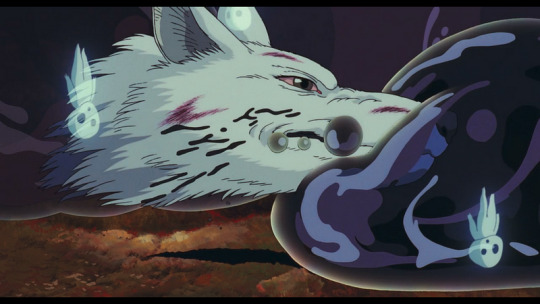
Wolf god Moro’s decapitated head after she mutilated Lady Eboshi. © Studio Ghibli
2.The Night Parade of One Hundred Demons Picture Scroll and Howl’s Moving Castle This is more of a visual than content resemblance. The big headed tengu and courtesan riding the cart instantly reminded me of the Witch of the Waste’s disproportionate head when she is similarly looking through the window of her palanquin carried around the city by her loyal henchmen.
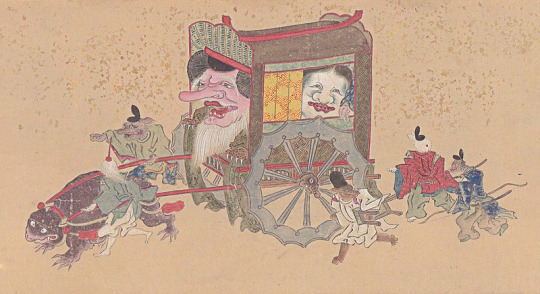
Tengu and courtesan riding a cart pulled by a toad. Source: The Japan Foundation
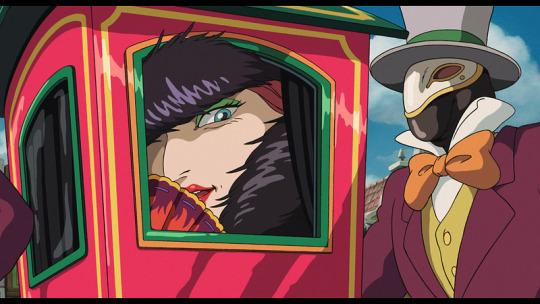
Close-up of the Witch of the Waste. © Studio Ghibli
3.The Nue and Princess Mononoke’s Forest Spirit If you have ever leafed through The Art of Princess Mononoke book you might know that the Forest Spirit (shishigami) didn’t always have that same soothing smile and piercing eyes that are both amicable and cruel. In the early stages of his development his face was more human-like and uncanny than it is now. Though at first glance he resembles a deer, the Forest Spirit is actually a combination of several animals. This blog post lists them as follows: a red-monkey face covered with blue patterns, cat eyes and nose, goat ears, big body of a wild boar, the fur of a serow, and the tail of a dog. As a whole his appearance is one overflowing with peculiarity.
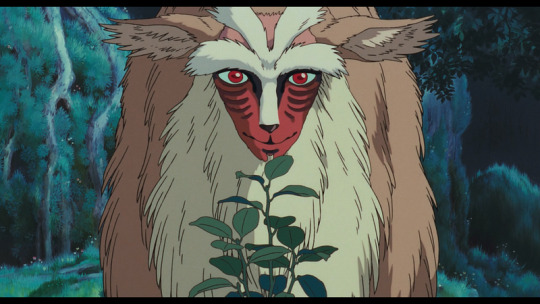
The Forest Spirit preying on a Shinto tree branch. © Studio Ghibli
Similarly the Nue, a legendary yōkai or mononoke, in The Tale of the Heike, is described as having the head of a monkey, the legs of a tiger, the body of a dog and the front half of a snake for a tail. In other writings it is sometimes depicted to have the back of a tiger, the legs of a tanuki, the tail of a fox, the head of a cat, and the torso of a chicken.
The Nue is also said to have the ability to shape-shift, often into the form of a black cloud that can fly. Much like the Forest Spirit who at nightfall changes to the giant Nightwalker (deidarabotchi).
Another similarity worth mentioning is that in both cases the mythical creature is indirectly murdered by the Japanese emperor. Lady Eboshi intends to give the Forest Spirit’s head, which is believed to grant immortality, to the Emperor in return for protection from Lord Asano. In The Tale of Heike, the samurai Minamoto no Yorimasa slays the Nue, because its very existence causes fear in the Emperor who falls ill and is unable to recuperate.

Minamoto no Yorimasa defeats the mythical beast Nue. Source: The Japan Foundation
4.The Foot Washing Mansion and Spirited Away This nishiki-e print depicts a large-footed yōkai monster that descends from the ceiling and demands to be washed. The story is one of seven stories in the famous Seven Wonders of Honjo and goes as follows: At the time when the flowers were sleeping and the ushimitsu plant was blooming, a horrible, rotten stench would invade the house, and a giant foot bristling with hair would descend from the ceiling accompanied by an enormous sound. If you washed the foot, it would soon disappear back into the ceiling. But if you didn’t, the giant foot would rampage through the house until satisfied.
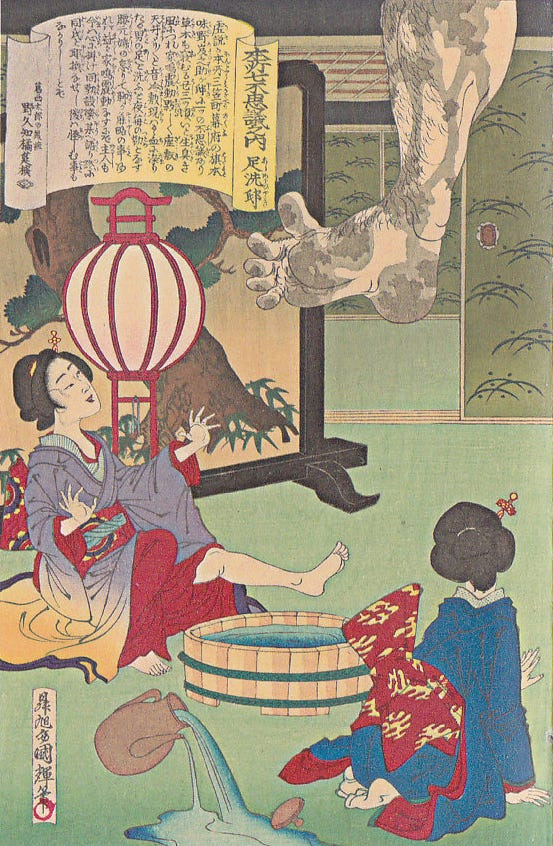
The large-footed yōkai descending from the ceiling. Source: The Japan Foundation
Most of Spirited Away’s plot takes place within a bathhouse for gods and spirits, known as kami, whose proprietor is the greedy witch Yubaba. The majority of these kami habitually visit the bathhouse for a regular wash to keep themselves clean — unlike the unwelcome enormous and foul smelling guest who imposes his presence and causes turmoil. He smells so bad that at first everybody, unsuccessfully, tries to prevent him from entering the bathhouse. Eventually they realise he is harmless — only after Chihiro cleanses him and sets him free from the taint of humanity.
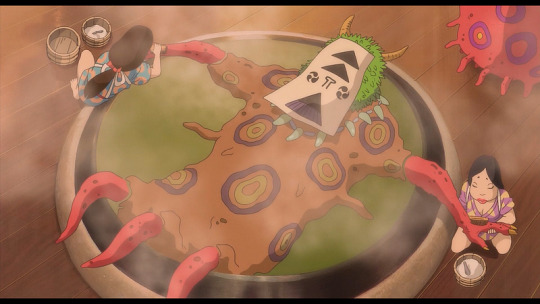
A kami being washed at Yubaba’s bathhouse. © Studio Ghibli
5.Tsuchigumo and Princess Mononoke’s Tatarigami Tsuchigumo, which literally translates to “dirt/earth spider” is a historical Japanese derogatory term for renegade local clans, and also the name for a race of spider-like yōkai in Japanese folklore.
From the Japanese middle ages (Kamakura/Muromachi/Azuchi-Momoyama periods, or the late 12th to the early 17th centuries) onward, these renegade clans i.e. Tsuchigumo began to be depicted as giant, monstrous spiders. In The Tale of Heike, the samurai Minamoto no Yorimitsu, a member of one of the ruling clans, is depicted how he heroically defeats a giant spider yōkai known as the Tsuchigumo — which is actually a metaphor for him exterminating his opponents.
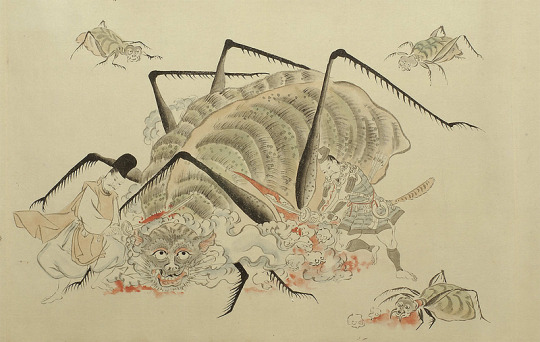
The Samurai Minamoto no Yorimitsu defeats Tsuchigumo i.e. the clans opposing him. Source: The Japan Foundation
Tatarigami (i.e. “cursed god”) is the giant creature from Princess Mononoke that attacks the Emishi village and curses its last prince, the protagonist of the movie, Ashitaka. Behind the shape, resembling a giant spider covered in worms, hides the colossal boar god Nago. Nago is the first god that Lady Eboshi shoots using the then newly developed hand cannons. The iron ball lodged in the boar’s body causes him great pain, which only intensifies his anger and hatred towards humans. Blinded by his desire for revenge, he goes far to the east where, instead of Lady Eboshi, he punishes the native Emishi tribe. While trying to protect his village, Ashitaka kills the demon, but unfortunately the curse falls on him causing the young leader-to-be to leave his homeland.
The aboriginal Emishi tribe that Ashitaka comes from is one of these renegade clans that have been fighting for 500 years against the Japanese emperor — Yamato. They have been losing against him, and now, with their last prince being cursed to death, they are certain to die out.

Tatarigami getting ready to attack the village of the Emishi tribe. © Studio Ghibli
As the samurai Minamoto no Yorimitsu exterminated the opposing clans — Tsuchigumo, so did Ashitaka in a way, by killing the Tatarigami, wipe out this endangered renegade clan, i.e. his own people. Thinking of it this way, the weight Ashitaka bears is enormous.
6.Personified Daikon Radish and Spirited Away’s Oshirasama According to Japanese ideas of animism, spirit-like entities are believed to reside in all things, both the living and the dead, including natural phenomena and objects. Kami and yōkai inhabit the spirit domain and in shape or nature can be either humans, animals, plants, natural phenomena or artifacts. Like for example this daikon radish (can you spot it?) appearing on omocha-e play pictures made for children’s entertainment as early as the Meiji era (1868–1912).

Yōkai-themed omocha-e. Source: The Japan Foundation
Root vegetables like radishes and carrots have often become internet sensations due to the occasional deformations they suffer. Their wonky shapes might have displeased a farmer in the past and ended up in the garbage instead of as pickles. Similar destiny had already befallen the objects of a house possessed by spirits. Discarded while the house was being exorcised, the aggrieved objects transform into yōkai and start plotting their revenge.
Oshirasama (Radish Spirit or Great White Lord) is the white, hefty, slow-moving guest at Yubaba’s bathhouse who resembles a radish sumo wrestler. His name, Oshirasama, is also the name of a kami of agriculture in the Shinto faith.
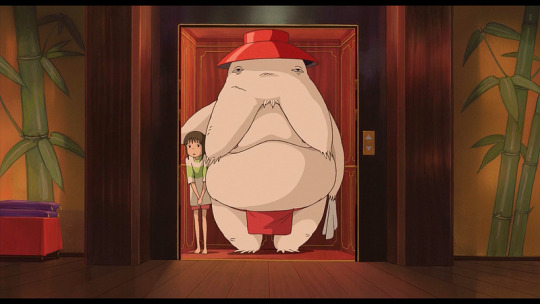
Radish Spirit riding the elevator alongside Chihiro. © Studio Ghibli
Have you noticed any of these? Do you perhaps know of another reference I might have missed out. How about re-watching the above mentioned films with this newly gained perspective? Japanese folklore is rich, extraordinarily original and beautiful. And so are Studio Ghibli’s films.
Source
#princess mononoke#studio ghibli#hayao mizayaki#japanese folklore#yokai#japanese history#spirited away#howl's moving castle#ghibli and yokai
24 notes
·
View notes
Text
Ghibli Gazebo: Princess Mononoke, Yakul is so precious
Ashitaka, prince of a tribe thought long dead, rides his red elk over sublime Japanese valleys. The clouds overhead look soft enough to touch.
Princess Mononoke is beautiful. I mean the film, but also certainly our titular heroine who Ashitaka wonderingly compliments with that very adjective. The film incorporates themes of nature vs. civilisation, female leadership, diplomacy, dying peoples and organized persecution of communities. The themes of advancing human technology we last saw in Kiki’s Delivery Service is now the point of conflict between forest gods seeking to protect their ancient homes and a burgeoning mining town. Ashitaka with “eyes unclouded by hate” seeks a diplomatic solution and amazingly remains truly bipartisan. While the obvious overarching message is protection of nature (and San and the wolves definitely appear more sympathetic) we are also awarded a layered glimpse into the greyer camp: the entrepreneurial Lady Eboshi and her loyal villagers. An interesting plot point is Eboshi’s repurposing of women “wasted in the brothels” to not only work the forges but also defend Irontown from samurai attacks. However, one of them mentions that their shifts last four days and it gives me pause.
Ashitaka and San’s relationship is handled with delicacy and the ending is surprising but excellent. San is never subjugated to Ashitaka and never objectified through his lens, but simply absorbs his ideas while her worldview remains her own and the choices therein too. It's an uplifting thought.
4 notes
·
View notes
Photo
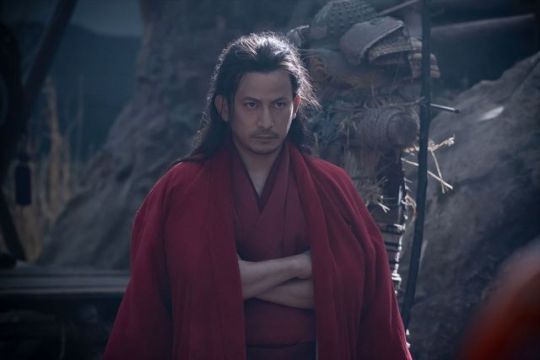
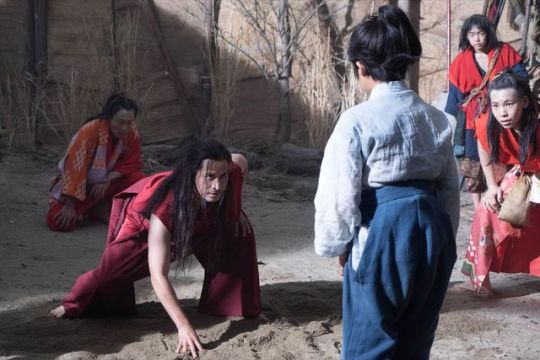
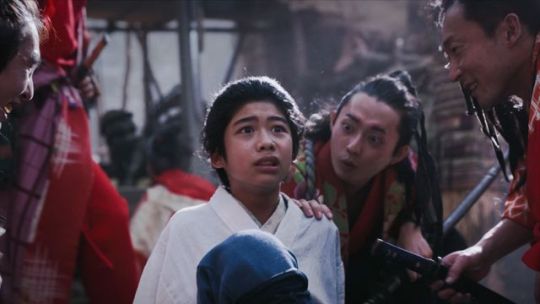
I only skipped straight to the Nobunaga scenes out of curiousity, so don’t ask me about my opinion of the Dousuru Ieyasu drama yet.
I'm surprised to find out that the teaser shots of Nobunaga with loose hair and red attire that was shown on Twitter was actually supposed to be Nobunaga in his youth.
The red clothing does make sense, as the Shinchoukouki describes that Nobunaga and his retinue of pages and attendants were all garbed in red. My surprise comes more from how old Okada Junichi looks in this scene (he was even sporting a light moustache), even though Nobunaga should still be in his teens. His father Oda Nobuhide is not even dead yet.
Usually dramas would hold off the facial hair until Nobunaga is supposed to be in his later years, especially if they use the same actor to act as both the young Nobunaga and his older version. If the actor is not young anymore, having even the slightest amount of facial hair makes them glaringly old. The “adult Nobunaga”, from what is presumably the Okehazama scenes, looks younger than this “teenaged Nobunaga”.
The choice to style the hair loose like this is also a unique choice, I do not believe I’ve ever seen Nobunaga wearing his hair like this in a “serious” historical live action movies or drama. I’ve only seen it when Nakamura Hashinosuke was Nobunaga in Kiriya Kazuaki’s Goemon movie, which purposely had a more game-like/fantasy feel to it. See below:
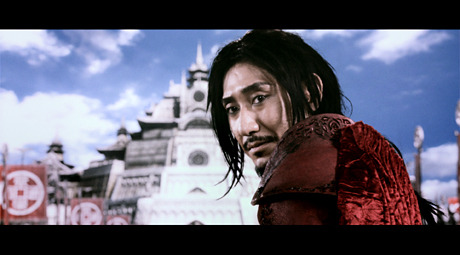
In a standard historical Sengoku movies, loose hair were usually seen in battle, worn under a hikitate-eboshi while the samurai is in armour, like this:
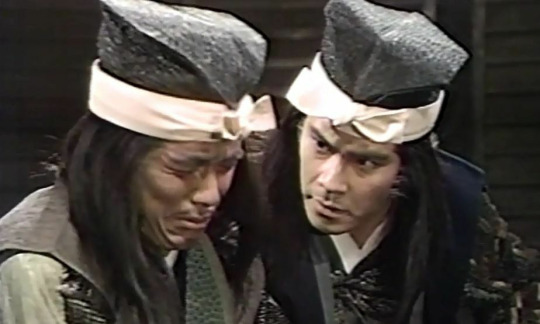
Or sometimes during death/execution scenes.
I imagine I could’ve mistaken the scene for a Chinese historical or fantasy drama if I was just shown screenshots, not the entire scene in context. Especially this rather odd scrappy “fort” that Nobunaga’s little gang has:
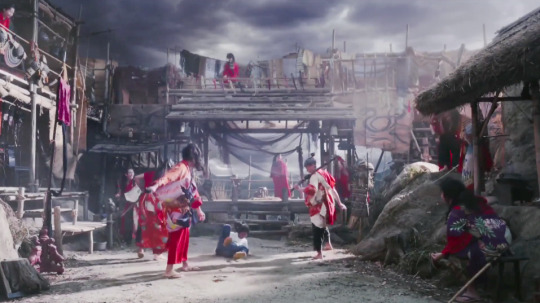
It has more the vibes of a Chinese bandit gang, often seen in wuxia/martial arts series. I vaguely recall of a wuxia story featuring a “beggar’s sect” with this kind of hideout. Nobunaga and his retinue were also acting like thugs too.
Honestly, it feels like the direction this is going is more like “a live action adaptation of a manga” kind of look and feel. The atmosphere I’m getting from this is reminiscent of this manga called Sanzoku Ou by Sawada Hirofumi. It’s a historical manga, but with a touch of fantasy and typical shounen hot-blooded energy. Hopefully it doesn’t hurt the series too much, as I’ve seen reports that Japanese viewers were so upset they ditched the series on episode two because it’s too outlandish.
If I have time to watch more than just a couple clips I might also give some more detailed comments.
5 notes
·
View notes
Note
ohhh please tell me your thoughts about Princess Mononoke, i've only seen it once (fairly recently) but i'd love to hear someone's thoughts other than my mom who didnt "get" it
anon I've had this in my inbox for a couple of months now because I've been trying NOT to go on a whole rant about the movie and have something coherent to say. but I was thinking about it last night as I was answering other asks and I've got something to say.
the post that I think inspired this ask was a result of me watching Brother Bear for the first time with some friends and one of them (knowing I love the movie) called it the American Princess Mononoke which (even based on my basic knowledge of BB) I called bs on. (I loved the movie don't worry but it was wildly different from Princess Mononoke). But anyway, after the movie was over we kept talking about Princess Mononoke and we started on Lady Eboshi and I remembered that some people have different interpretations on her than I do (and the movie itself does).
The way the movie deals with morality is so interesting, especially in how it intersects with the theme of nature vs civilization. Because it could be seen as a kind of standard, "save the forests, civilization is bad and evil" lesson. And that would be valid. the plot kicks off because Lady Eboshi brought in her guns and rifles and killed one of the forest gods and Nago ended up cursing Ashitaka. the massacre led by the samurai, killing off all those villagers. Iron Town itself, destroying the entire mountain and Lady Eboshi eventually killing the Forest Spirit. It's demonstrated over and over again that humans are Shit and destroying nature. it would have been so easy portray humans and their civilizations as the villains here.
Except it's more complicated than that. Because the people who are making up Iron Town are essentially refugees from the rest of civilization, people who have been forgotten in the rest of the world - brothel girls, lepers. Lady Eboshi comes along with her warriors and her rifles, and she destroys the mountain, kills the forest and the boars, but she also creates a safe haven for the people who were at risk. she creates a society where these people can live freely and also where they don't have to live in fear of whoever is in charge. everyone respects her but also they don't fear her, the women and lepers can joke and talk freely as much as they want.
And what's more, is that Lady Eboshi is shown to not just be using them, she actually wants to help them. She wants to heal her lepers and keep their town safe, training her girls to use the rifles so they can defend themselves when they need to. I think the scene that shows this best is the scene where she introduces Ashitaka to the lepers for the first time. They walk into the building and Ashitaka - himself carrying a sickness, shown to be kind and compassionate contrasting Eboshi's ruthlessness - is immediately on guard when he sees the lepers inside, while Eboshi walks straight inside and interacts with them without a care in the world, and apologizes for working them so hard and gives them wine. She cares about these people and she wants to give them a cure, and failing that, then a place where they can live their lives safely. Even the ones who can't help - Osa, the one with the "life is suffering, but you still find reasons to keep living" speech, is shown to be very sick and resting, and when he speaks it's treated as a surprise - are treated kindly, they aren't kicked out because they can't do anything for her.
And this still doesn't change the fact that she and her civilization is destroying the land, but it does change the tone. She's not doing it for no real reason, or simply for power. She's creating a safe haven for people ignored or downtrodden by society. She kills the forest spirit, she destroys the forest - even if she encourages a path with no loss of (human) life, she intends to destroy it slowly and surely - she leads to Ashitaka being cursed and could have lead to who knows how many other demons being born. She stands for civilization itself and what happens when it expands without concern for nature.
But she also creates this moral conundrum of what you do in a situation where you and the people who follow you - who you care about - don't have anywhere else to go and live freely. And it brings up the question of what things you're willing to do to get you and your people that safety. And I love the complexity of the situation because it turns the movie into more than just man vs nature. I mean, it still is, but it becomes so much more complicated in how we solve the problem. And the answer isn't one or the other, it has to be both.
(I have a concern that people are going to take this as me defending colonization or something and I just want it clear that I don't.)
4 notes
·
View notes
Text
Ashitaka: can you show me your secrets?
Lady Eboshi: no, you're probably a spy sent by the emperor, the local samurai lord, that monk who is trying to get leverage on me, or maybe the wolves somehow?
Ashitaka: none of the above, I swear. Also right now I am exerting a herculean effort to stop myself from killing you and if I waver for even a moment you will be dead where you stand.
Eboshi: Ok, I'll show you my secrets
1 note
·
View note
Text

2018 saw the launch of the Gridman Universe from Trigger with SSSS.Gridman. This 12 episode reimagining borrowed concepts and names from unproduced content from the 90s to create a whole new story, and new merchandise for Gridman's new forms, plus tonnes focused on specific characters. Some spoilers under the cut as we talk about all the media that spun off from it.
Starting with the most closely connected media.
Episodes 1-11 were each accompanied by a short Voice Drama that explained on various characters, with an additional 4 coming as Blu-ray pack-ins. An album was produced with Character Songs for all the main cast.
Prior to the release of the anime, Director Amemiya authored two online short stories set in the school over the months prior. These were "Uniform from a School I don't know" focused on the characters of Furuma Ako and Marusan, and "Don't peak inside" focused on Yonezawa Yoshitaka and Tonkawa Sakiru.
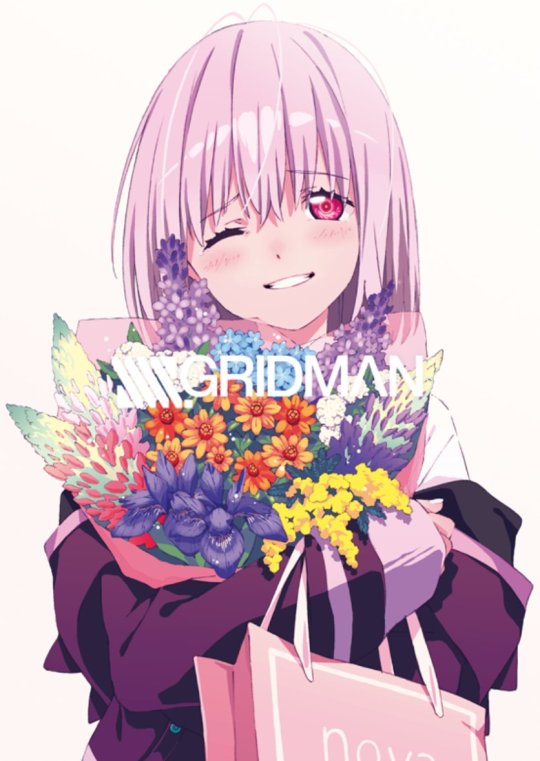
The Special Signature to Save a Soul fanbook included a manga short from Amemiya, depicting Rikka spitting Anti and the Kaiju Girl a few months after the show. Meanwhile the MV for UNION, the OP from OxT continued a certain other character's story.
Author Mizusawa Yume of "Ore no Twintail" fame, who will be coming up a lot, penned an original story "The Diamond in the Notebook" for the Super Complete Works, seeing Utsumi inspired to create a record of Gridman and his abilities.
An alarm app featured special voice lines from Akane and Rikka.
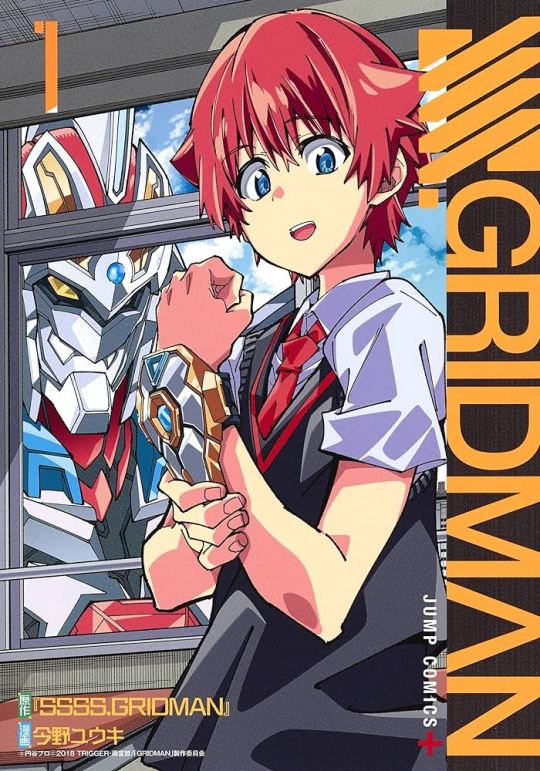
A manga adaptation of the show was produced, somewhat expanded, over 6 volumes. In addition there were 3 manga anthologies, one general, as well as Side:Rikka and Side:Akane.
More unique manga spin-offs followed
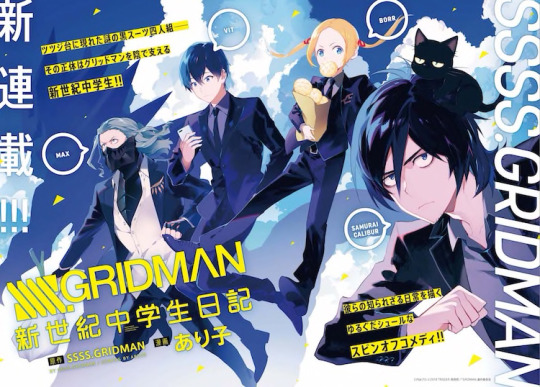
Neon Genesis Junior High Student Diary focused on the daily lives of those 4 during the events of the series.

Neon Genesis Junior High Student Butler Cafe meanwhile, saw the world briefly changed so they ran a butler cafe within Aya.

Hime and Samurai saw Calibur, shortly before the anime, team up with Kizuki Hime to investigate the goings on in Tsutsijidai.

Sengoku Gridman saw, in another world, Gridman join with the boy Eboshi to protect his sister from the evils of war.

Gridman Dogma saw misfit Neon Genesis Junior High Students Vice, Mari and Bane join with mysterious "Gridman" Chloe to protect pitiful people.

Mizusawa Yume and bun150's SSSS.Gridman Novelizations told the story of the world being trapped in a loop between episodes 8 and 9, and featured many original combinations, as well as the media debut of Full Power Initial Fighter Gridman and Full Power Gridman Over Spec Mode.
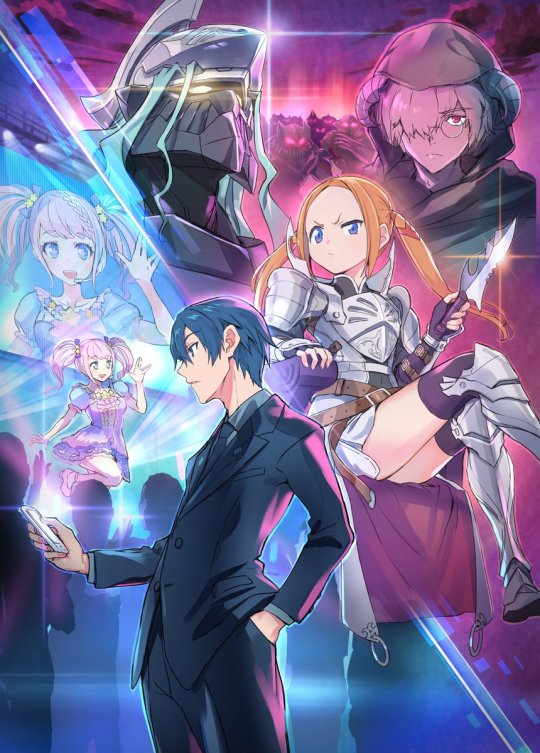
While SSSS.Gridman ANOTHER LOAD told a story before the anime of Vit and Borr on separate worlds with intertwining threats, even as Vit manages and Idol while Borr has become the Demon King.
Gridman Universe: Complete Breakdown
At time of writing, the Gridman Universe Show is about to happen, and if nothing major is announced, we may be putting a cap on the Gridman Universe for now. This isn't going to be fully comprehensive, but I do want to share info on the things that are harder to find.
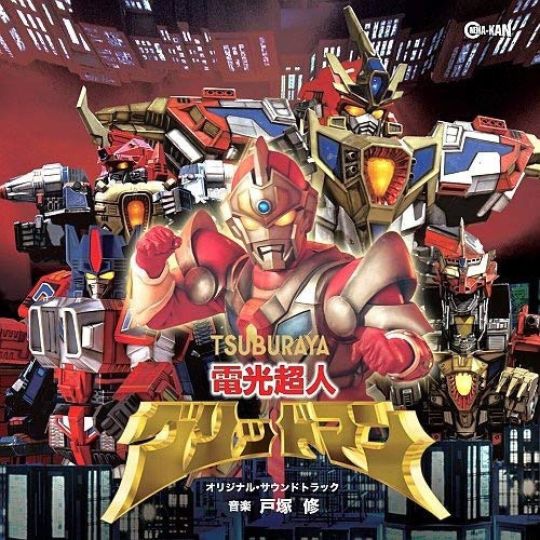
Denkou Chojin Gridman, aka Gridman the Hyper Agent, was a 1993 Tokusatsu series by Tsuburaya based on toy concepts by Takara. A Hyper Agent joins with a group of youths for help to defeat an other dimensional criminal, and they are responsible for both his form and his Assist Weapons.
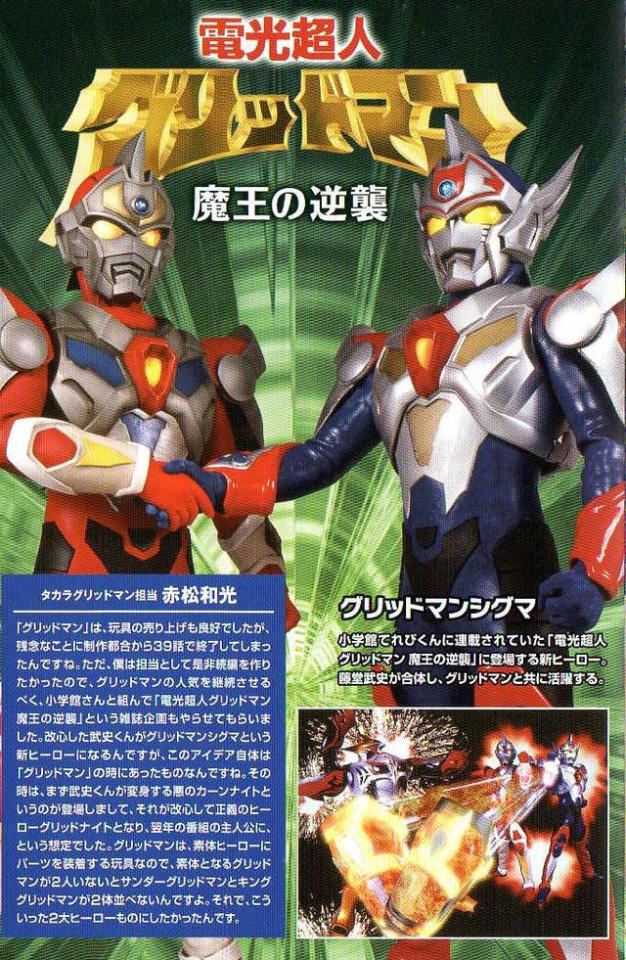
Followed the next year by a photo sorry, Demon King's Counterattack, which introduced Gridman Sigma to help fight a new threat, and introduced a couple more form variations.

In 2015, Trigger gave us the short boys invent great hero, part retelling of the show and part reimagining of Demon King's Counterattack. But more important, is what it lead to.
26 notes
·
View notes
Text
Other formal outfits of Heian ancestry - Kariginu, Hoi and Nôshi attires
(as worn by samurai of the Edo period - great charts by Nadeshico Rin). You can find more about samurai ranks and their regulated attires under the tag "samurai kimono".
The Kariginu
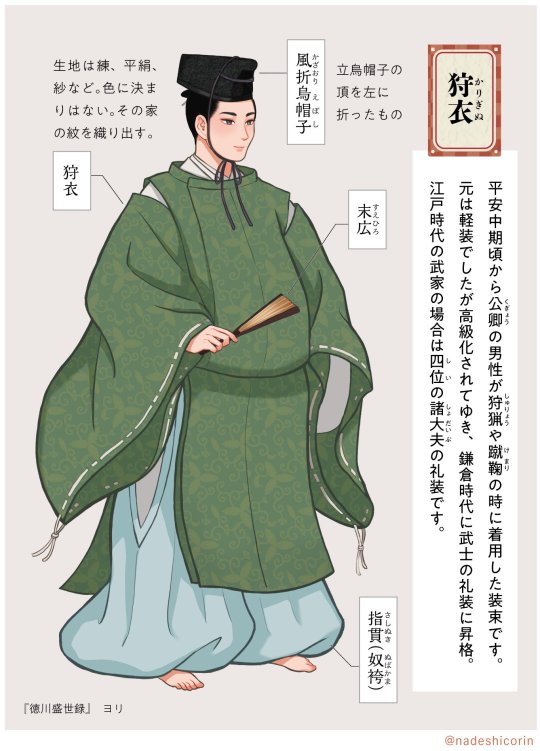
狩衣 Kariginu first appeared during Heian period where they were informal attires worn by kuge (nobibilty) men for activities such as hunting and 蹴鞠 kemari ball games.
Kariginu rose to formal status during Kamakura period when it started being worn by the buke (warrior class). In Edo period, it was worn by upper-ranked samurai (4th rank and above).
Edo-period kariginu designates a patterned clothing (different from the hoi, see below), often decorated with the family 紋 mon (crest). Colors were not regulated.
風折烏帽子 Kazaori-eboshi - black-lacquered hat made of silk, cloth or paper, originally worn by Heian nobility. Many eboshi shapes exist, this one is a upright style (tate-eboshi 立烏帽子) with top folded to the left.
末広 Suehiro - a type of formal folding fan. TN: the fan drawn here ressemble more a 中啓 chûkei, as suehiro have curving ribs which don't seems to be the case here (find more about fan types here)
指貫 sashinuki (or 奴袴 nubakama) - large bouffant pants. Also, note the bare feet! Rin doesn't comment this but this was probably a way to put it below sokutai and ikan (which do have socks)
袖括 Sodekukuri - decorative sleeve ties. Originally appeared on Heian clothings (like kariginu, nôshi, etc) where they were used to tighten sleeve cuffs.
The Hoi
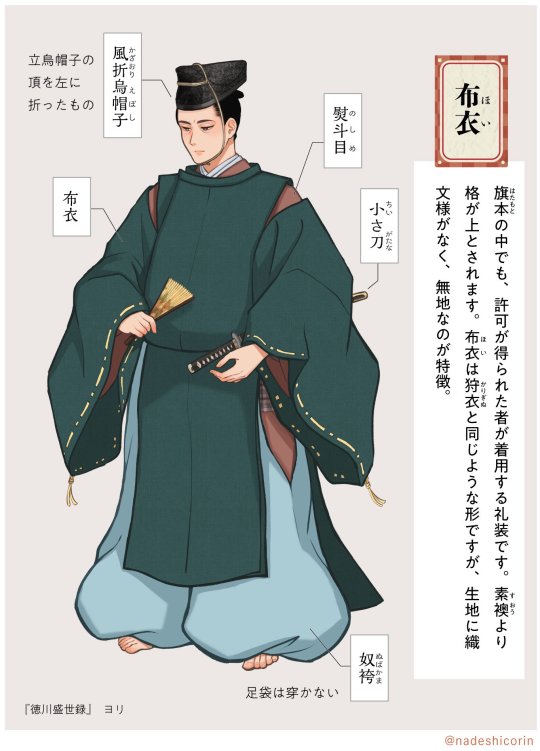
布衣 Hoi is a variation of 狩衣 kariginu (see above).
During Edo period, it was worn by some hatamoto (6th rank samurai) via explicit permission of the shogunate - setting those rewarded by this honor apart from other vassals of the same rank.
Compared to kariginu, hoi were plain solid color.
It is worn here over a 熨斗目 noshime, a samurai kosode (=ancestor of the kimono) with stripes or lattice pattern at waist area.
As for the kariginu, note the bare feet!
The Nôshi
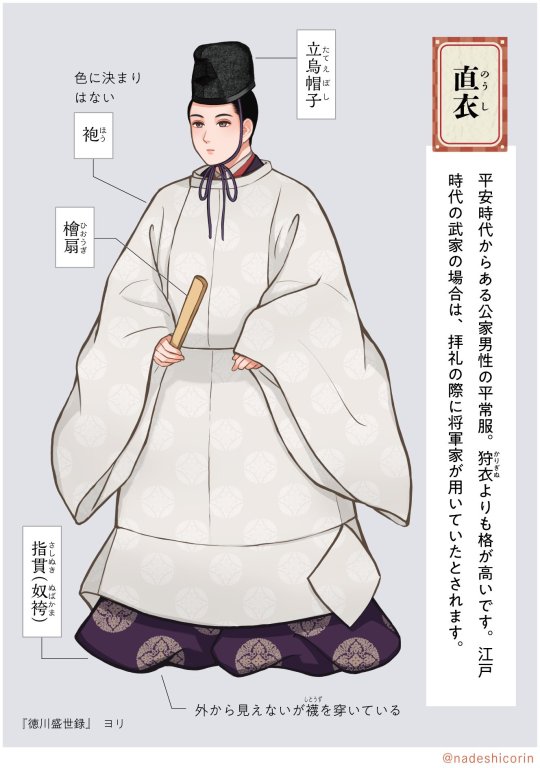
直衣 Nôshi was a type of everyday robes which were first worn by males of the imperial family during Heian era. Formality placed it then above kariginu.
Overtime, their use spread among nobility, and by Edo period, they were a "tad-formal" attire worn by Shogun's family for worship celebrations.
立烏帽子 Tate-eboshi - upright lacquered hat
袍 Hô - round-necked robe with large boxy sleeves
檜扇 hiôgi - formal folding fan made of cypress, also of Heian history. Those were unpatterned as painted ones were for women
指貫 Sashinuki (or 奴袴 nubakama) - large bouffant pants
#japan#fashion#fashion history#samurai kimono#samurai#nadeshico rin#ressources#reference#kariginu#hoi#noshime#hatamoto#buke#warrior class#edo era#edo period#heian period#着物#Kazaori-eboshi#Suehiro#chûkei#sashinuki#nubakama#Sodekukuri#men kimono#Tate-eboshi#Hô#hiôgi#Sashinuki
256 notes
·
View notes
Text




My Inktober/Fanartober prints are up for sale! These are 6x6 prints! Follow the link to get a few of your own! 🥰
#fanartober2020#fanartober#inktober 2020#inktober#princess mononoke#ashitaka#San#lady eboshi#ranma 1/2#ranma#samurai champ ooo#zelda#breath of the wild#botw#link#fullmetla alchemist brotherhood#fma#ed and al#olivier armstrong#avatar#atla#aang#appa#katara#final fantasy ix#final fantasy 9#ff9#Zidane#princess garnet#sailor starlights
2 notes
·
View notes
Text
Left side: Feraud from The Duellists Marlfoxes from Redwall Magua from Last of the Mohicans Right side: Lady Eboshi from Princess Mononoke Kikuchiyo from Seven Samurai Darcia from Wolf's Rain

Left: Slagar- You know this one Reaver from Fable, you know this one too Reynard the Fox Right: Val Kilmer as Doc Holliday Tatujapa fox boy Gotz von Berlichengen, mercenary knight famed for having an iron hand prosthetic, being a poet, and supposedly one of the first people recorded to tell his enemies to eat his ass

#oc lore#inspiration meme#redwall#humblewood#darcia#wolf's rain#princess mononoke#the duellists#last of the mohicans
11 notes
·
View notes
Photo



Lady Eboshi inks
#artists on tumblr#art#traditional art#drawing#ink#inks#sketch#sketchbook#ghibli#anime#fanart#Princess Mononoke#Mononoke Hime#lady eboshi#woman#samurai#character#design
797 notes
·
View notes
Text
Five Yōkai references to Studio Ghibli films
An avid lover and aficionado of Studio Ghibli’s work, I see references to and from it practically everywhere. Most recently at an exhibition about yōkai.
Yōkai are a class of supernatural creatures that roam the realm of spirits in Japanese folklore. The Japan Foundation organised traveling exhibition titled “Yōkai: Supernatural Monsters from Japan” introduces these curious spirits through a diverse range of media, including nishiki-e prints, emaki picture scrolls, sculptures, toys and films.
Apart from the harmonious and subtle color palettes, the lush and peculiar imagination of the ancient artist, his experienced hand drawing each brush stroke, and the excitement of seeing a picture scroll in real life, what really intrigued me were the images that looked like a scene from a Studio Ghibli film. Listed below are some of the references I spotted.
1.Mount Ōe Picture Scroll and Princess Mononoke First in line was this one illustrating the heroic tale of the brave samurai Minamoto no Yorimitsu, who, according to legend, exterminated the quintessential yōkai Shuten-dōji, a mythical oni or demon leader of Japan. Although decapitated, the demon’s detached head still took a bite at the hero, who avoided death by wearing multiple helmets stacked on his head.
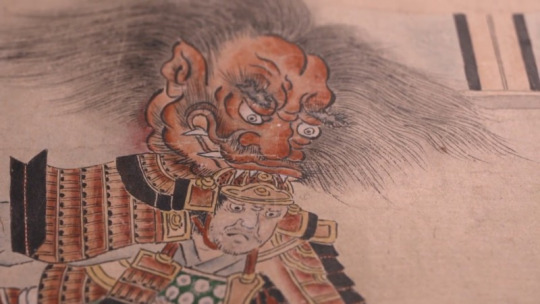
Close-up of Shuten-doji biting at his decapitator. Source: The Japan Foundation
In Princess Mononoke, on a few occasions Lady Eboshi warns her people that it will take more than a single shot to kill a wolf god: “A wolf’s severed head can still bite.” Ignoring Ashitaka’s warning and attempt to stop her from committing yet another godslaughter, Eboshi succeeds in murdering the Forest Spirit. This victory is short-lived, however, as soon after Eboshi gets her well-deserved punishment for angering the gods when the wolf god Moro’s decapitated head bites off her right arm: “Moro’s head. It moved on its own,” feels like Eboshi had foreshadowed her own misfortune.
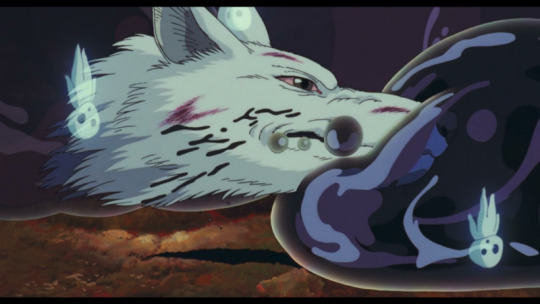
Wolf god Moro’s decapitated head after she mutilated Lady Eboshi. © Studio Ghibli
2.The Night Parade of One Hundred Demons Picture Scroll and Howl’s Moving Castle This is more of a visual than content resemblance. The big headed tengu and courtesan riding the cart instantly reminded me of the Witch of the Waste’s disproportionate head when she is similarly looking through the window of her palanquin carried around the city by her loyal henchmen.
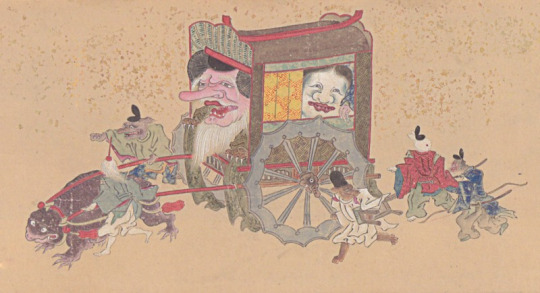
Tengu and courtesan riding a cart pulled by a toad. Source: The Japan Foundation

Close-up of the Witch of the Waste. © Studio Ghibli
3.The Nue and Princess Mononoke’s Forest Spirit If you have ever leafed through The Art of Princess Mononoke book you might know that the Forest Spirit (shishigami) didn’t always have that same soothing smile and piercing eyes that are both amicable and cruel. In the early stages of his development his face was more human-like and uncanny than it is now. Though at first glance he resembles a deer, the Forest Spirit is actually a combination of several animals. This blog post lists them as follows: a red-monkey face covered with blue patterns, cat eyes and nose, goat ears, big body of a wild boar, the fur of a serow, and the tail of a dog. As a whole his appearance is one overflowing with peculiarity.

The Forest Spirit preying on a Shinto tree branch. © Studio Ghibli
Similarly the Nue, a legendary yōkai or mononoke, in The Tale of the Heike, is described as having the head of a monkey, the legs of a tiger, the body of a dog and the front half of a snake for a tail. In other writings it is sometimes depicted to have the back of a tiger, the legs of a tanuki, the tail of a fox, the head of a cat, and the torso of a chicken.
The Nue is also said to have the ability to shape-shift, often into the form of a black cloud that can fly. Much like the Forest Spirit who at nightfall changes to the giant Nightwalker (deidarabotchi).
Another similarity worth mentioning is that in both cases the mythical creature is indirectly murdered by the Japanese emperor. Lady Eboshi intends to give the Forest Spirit’s head, which is believed to grant immortality, to the Emperor in return for protection from Lord Asano. In The Tale of Heike, the samurai Minamoto no Yorimasa slays the Nue, because its very existence causes fear in the Emperor who falls ill and is unable to recuperate.
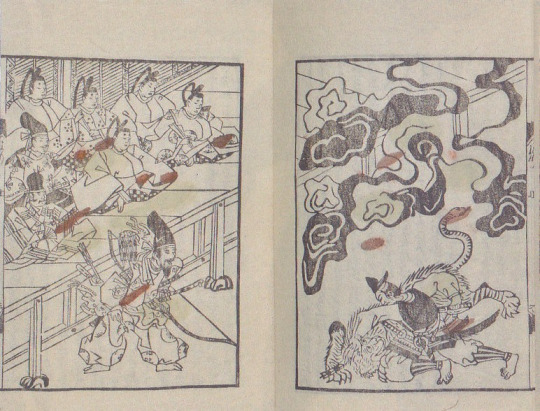
Minamoto no Yorimasa defeats the mythical beast Nue. Source: The Japan Foundation
4.The Foot Washing Mansion and Spirited Away This nishiki-e print depicts a large-footed yōkai monster that descends from the ceiling and demands to be washed. The story is one of seven stories in the famous Seven Wonders of Honjo and goes as follows: At the time when the flowers were sleeping and the ushimitsu plant was blooming, a horrible, rotten stench would invade the house, and a giant foot bristling with hair would descend from the ceiling accompanied by an enormous sound. If you washed the foot, it would soon disappear back into the ceiling. But if you didn’t, the giant foot would rampage through the house until satisfied.

The large-footed yōkai descending from the ceiling. Source: The Japan Foundation
Most of Spirited Away’s plot takes place within a bathhouse for gods and spirits, known as kami, whose proprietor is the greedy witch Yubaba. The majority of these kami habitually visit the bathhouse for a regular wash to keep themselves clean — unlike the unwelcome enormous and foul smelling guest who imposes his presence and causes turmoil. He smells so bad that at first everybody, unsuccessfully, tries to prevent him from entering the bathhouse. Eventually they realise he is harmless — only after Chihiro cleanses him and sets him free from the taint of humanity.
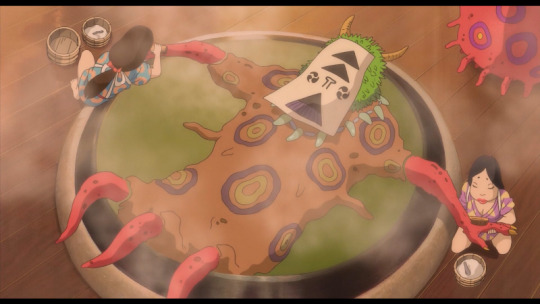
A kami being washed at Yubaba’s bathhouse. © Studio Ghibli
5.Personified Daikon Radish and Spirited Away’s Oshirasama According to Japanese ideas of animism, spirit-like entities are believed to reside in all things, both the living and the dead, including natural phenomena and objects. Kami and yōkai inhabit the spirit domain and in shape or nature can be either humans, animals, plants, natural phenomena or artifacts. Like for example this daikon radish (can you spot it?) appearing on omocha-e play pictures made for children’s entertainment as early as the Meiji era (1868–1912).
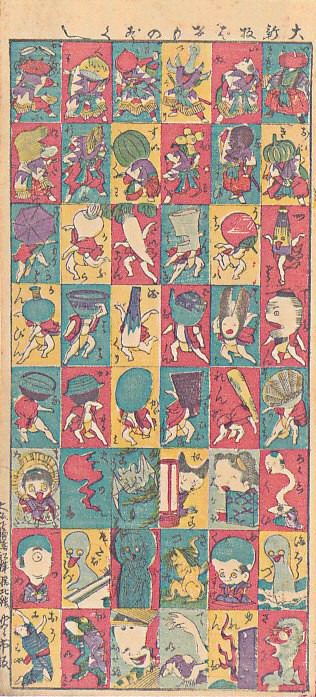
Yōkai-themed omocha-e. Source: The Japan Foundation
Root vegetables like radishes and carrots have often become internet sensations due to the occasional deformations they suffer. Their wonky shapes might have displeased a farmer in the past and ended up in the garbage instead of as pickles. Similar destiny had already befallen the objects of a house possessed by spirits. Discarded while the house was being exorcised, the aggrieved objects transform into yōkai and start plotting their revenge.
Oshirasama (Radish Spirit or Great White Lord) is the white, hefty, slow-moving guest at Yubaba’s bathhouse who resembles a radish sumo wrestler. His name, Oshirasama, is also the name of a kami of agriculture in the Shinto faith.

Radish Spirit riding the elevator alongside Chihiro. © Studio Ghibli
Have you noticed any of these? Do you perhaps know of another reference I might have missed out. How about re-watching the above mentioned films with this newly gained perspective? Japanese folklore is rich, extraordinarily original and beautiful. And so are Studio Ghibli’s films.
Source
#studio ghibli#ghibli films#hayao mizayaki#spirited away#princess mononoke#howl's moving castle#yokai#japan foundation#yōkai: supernatural monsters from japan#emaki#nishiki-e
98 notes
·
View notes
Text




EBOSHI
During the Heian Period, being seen without headgear was seen as a shameful thing, and so Eboshi hats or caps were worn at all times during waking hours. Made of lacquered cloth or even a soft gauze with a black, or more often white tie band, Eboshi were sometimes worn folded flat under kabuto (helmets) too. It was considered a grave insult to touch, let alone knock an Eboshi off anyone’s head.
Eboshi, and derivatives, continued to be worn by the samurai, particularly the elite until the end of the Edo period.
33 notes
·
View notes
Text
This hairstyle is not chasenmage, and Sengoku samurai rarely wear this
I’m talking about this hair:

(screenshot from Kirin ga Kuru)
This is not specifically about Nobunaga or anything, but 90% of the Nobunaga I see in Taiga drama and movies usually has this hair style, and I want to talk about it. There were some drawing guides I’ve seen online that mistakenly label this hair as “chasenmage”, and it’s somewhat misleading.
Chasenmage 茶筅髷, literally meaning “tea whisk hair”, is one of the hairstyles commonly worn in the Muromachi and Azuchi-Momoyama period aside from the folded topknot (orimage/chonmage). The hair is tied tightly with strings, leaving a small tuft at the end, making it resemble a tea whisk. However, even a high-angled chasenmage doesn’t go as far as stick straight up like seen above.
That being said, I say they “rarely” wear the sticking-up style, not “never”, because this hairstyle is actually "real”. It’s not a made-up style invented by Kabuki or movies, it’s just... incorrectly applied. This hairstyle is called kanmuri-shita no motodori 冠下髻 or hitotsu motodori 一髻. It’s the hairstyle worn under the kanmuri (court cap):
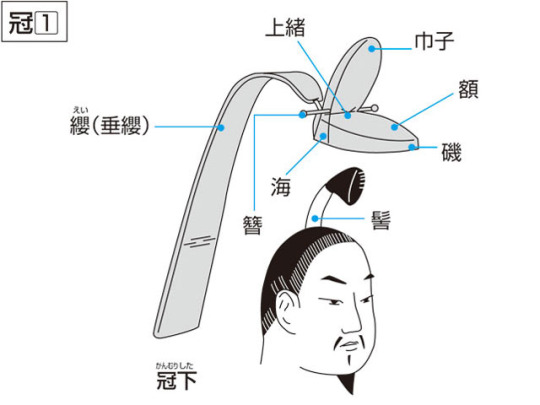
(image from Kotobank dictionary)
So if you want to be "accurate”, it’s fine Nobunaga or some other daimyou wears this hairstyle sometimes, but only if you’re showing they’re in the process of getting dressed or undressed from courtly attires (for meeting with the shogun or other courtly business).
It’s one thing if the character is the emperor or court nobles, as the caps are often part of the daily attire. It would make sense that they might keep their hair in kanmuri-shita style even in leisure. However, Sengoku daimyou wear their hair mostly in the folded topknot style, and there is no reason for them to constantly wear kanmuri-shita hair. And, once more, the kanmuri-shita is not the chasenmage that Sengoku samurai did frequently wear.

(Emperor Seiwa, shown with his hair in the kanmuri-shita style. From the Ban Dainagon Ekotoba 伴大納言絵詞 picture scroll)

Picture from Teijou Zakki 貞丈雑記, written by Ise Sadatake around 1763-1784, also describing that this hairstyle is meant to be worn under a hat (either an eboshi or a kanmuri, as mentioned above)
I can’t trace where/how it began, but at some point it seems that Kabuki actors starts wearing that hairstyle in their performances:

Ukiyo-e of Kabuki actors then influence ukiyo-e depictions of “historical events” of the Sengoku. Then, when people start making movies about Sengoku samurai maybe in the 50s and 60s, ukiyo-e and Kabuki costumes are probably the easiest source of reference, resulting in this long-standing “trend” to give Sengoku samurai this hairdo.

(Nobunaga wearing that now-“iconic” hairstyle in an ukiyo-e by Yōsai Nobukazu 楊斎延一)
Meta-wise speaking, it’s likely that studios maintain this “wrong” hairstyle to save on budget. It’s better to just reuse old wigs rather than spend more money to make a new batch of historically-accurate wigs. However, I don’t really see any reason for illustrated media maintaining this, other than “maybe the artist just didn’t know”. Unlike the image of Nobunaga wearing European armour, there is no real branding attached to this hairstyle, so there is no specific need to keep drawing this style. Far as I can tell, Sengoku enthusiasts are equally fine with seeing samurai wearing just a “normal ponytail”.
Or, if not, something like this:

The hairdo Koei likes to use for their Nobunaga’s Ambition portraits may not necessarily be an accurate chasenmage either, but it’s “less wrong” than the kanmuri-shita.
We end with what a “correct” chasenmage looks like, as depicted by paintings from the 16th century:

Some attendants from Nanban Byoubu by Kanō Naizen 狩野内膳 were shown wearing chasenmage.

Falconers from the Rakuchuu Rakugai screen, by Kanō Eitoku. *) The third person behind them that I did not mark is angled oddly, so I wasn’t able to identify if that was a chasenmage (more stiff, secured with more strings) or just a “floppy ponytail”.

Modern illustration for clarity, provided by Kotobank online dictionary.
31 notes
·
View notes